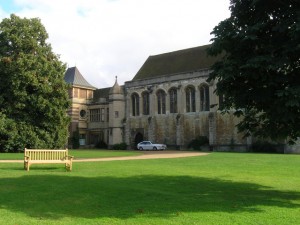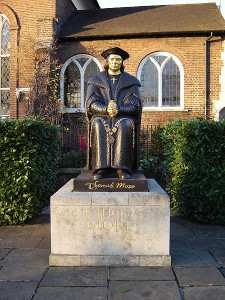Day 5
by Mike Glaeser
While I couldn’t make it out to Bosworth where the Tudor dynasty began, I did make it to another location where the life of Henry VIII first took form. Although born at Greenwich, Henry spent most of his childhood in the close quarters of Eltham Palace. It was here that he first learned to read and write under the tutelage of his mother, Elizabeth of York. It was also at Eltham where the Humanist scholar Erasmus first met the young Prince. So the story goes, Erasmus did not have a gift for Henry upon his introduction. At dinner, Henry challenged Erasmus to write something for him. The resulting poems wax about Henry’s future greatness and for his need to be a just prince.
Besides Henry, other Tudor figures have visited the palace as well. Cardinal Wolsey drew up the “Eltham Ordinances” in 1525 that set restrictions on courtier’s access to the King. Anne Boleyn was also at Eltham with her infant daughter Elizabeth in 1533-1534. Elizabeth would later return as Queen when she needed an escape from London.
Before we delve into the Tudor remnants, a bit of history: The exiting early medieval manor at Eltham was acquired by Bishop Bek in 1259. It was he who first created the moat and defensive wall while also extending the footprint of the building. The palace was heavily used during the reigns of Edwards II and III. It wasn’t until the 1470’s, under Edward IV, that Eltham received its current great hall. At 10.9 meters wide, it has the third widest oak hammer beam carved roof in England after Westminster Hall and Hampton Court. Because of the link to his childhood, Henry VIII spent lavishly to expand the palace. He added the all-important tiltyard in 1517. Shortly afterwards, he added newer lodgings for both himself and his Queen as well as a chapel complete with gilded lead oak leaves and carved oak walls. But, by the 1530’s, he had abandoned Eltham in favor of his grander palace at Hampton Court. By the time Elizabeth got to Eltham, parts of it were already falling apart. This would be the status quo for the next 300+ years until an effort in the late 1800’s preserved the ancient building(s). In the 1930’s it was remodeled as a modern family mansion. All that remains above ground today is the old great hall in a much-altered state.
To find any Tudor remains, one must take the outside garden tour.
Henry’s chapel no longer exists, but its foundations lie angled to the north of the great hall. It currently sits under the parking circle in front of the mansion. At the end of the great hall are a few unearthed ruins of the sovereign’s chambers with the King’s going left and the Queen’s going right. A 14th century corridor runs alongside them as well. Entering the moat, the layers of stonework become apparent. Tudor brickwork can be identified by its “diaper” styling; that is, red brick being interlaced with black bricks to form “X” patterns. This marks the site of lodging renovations from 1580. One last detail resurfaced in 1834. Workmen digging found the remains of the Henrician drainage system. These large tunnels helped funnel away used water and waste while pumping in fresh spring water from a nearby conduit that still exists today. These tunnels gave rise to the rumor that Henry was secretly building escape tunnels to Greenwich complete with underground stables! Unfortunately for us, these drains (big enough to walk through) have been buried again. So, if you ever want to see a Tudor Eltham, you will need to bring a shovel.
Back in London, I took a stroll down to Chelsea Old Church, which is on the Thames Embankment. A church has been on this site since the 13th century with the current Tudor version being heavily restored after German bombings. The church is linked to Sir Thomas More who had his family tomb built there in 1528. His wish to join the rest of his family was left unfulfilled due to his execution at the Tower of London. He now lies somewhere in St. Peter ad Vincula. As with all traitors, his head was placed on a spike on London Bridge. Tradition claims his daughter Margaret rescued the severed head and had it placed in the family tomb. It won’t be opened anytime soon to find out.
Roper’s Garden lies nearby. Formerly More’s orchard, a garden was planted by his son in law who is most famous for writing “The Life Of Thomas More”. The garden is still there today though there are no reminders of its past.
Tomorrow is the grand finale of this summer progress, a return (for the fifth time) to the Tower of London.
(Additional note: A statue of Sir Thomas More, by L. Cubitt Bevis, sits outside Chelsea Old Church and was erected in 1969.)























Can’t wait to see the Tower of London!
I am a direct descendant of Sir John Lawrence who is burried in the Lawrence Chapel in your church.